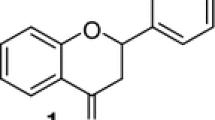Abstract
Fifteen structurally different 4C-substituted pyrrolidin-2-one derivatives were used as model analytes for investigation of enantioseparation abilities on six commercially available polysaccharide-based coated chiral stationary phases (cellulose tris (3,5-dimethylphenylcarbamate), cellulose tris (3-chloro-4-methylphenylcarbamate), cellulose tris (4-methylbenzoate), cellulose tris (4-chloro-3-methylphenylcarbamate), amylose tris (3,5-dimethylphenylcarbamate), and amylose tris (5-chloro-2-methylphenylcarbamate) under normal phase and polar organic separation modes. Influence of stationary and mobile phase type on resolution and elution order of enantiomers was studied. Results showed that the polysaccharide backbone of the stationary phase (amylose and cellulose) has a significant impact on chiral recognition, and the best separation was observed on amylose-based chiral stationary phases. It was established that steric effects play an important role on 4C-substituted pyrrolidin-2-one derivative resolution on polysaccharide-based chiral columns. Nature of alcohol in the mobile phase was also an important factor contributing not only to retention but also resolution. Although the use of the normal phase mode seems more beneficial, in certain cases, polar organic mode may increase the number of separated pairs of enantiomers.
Graphic abstract



Similar content being viewed by others
References
Veinberg G, Vavers E, Orlova N et al (2015) Stereochemistry of phenylpiracetam and its methyl derivative: improvement of the pharmacological profile. Chem Heterocycl Compd 51:601–606
Malykh AG, Sadaie MR (2010) Piracetam and piracetam-like drugs: From basic science to novel clinical applications to CNS disorders. Drugs 70:287–312
Zvejniece L, Svalbe B, Veinberg G et al (2011) Investigation into stereoselective pharmacological activity of phenotropil. Basic Clin Pharmacol Toxicol 109:407–412
Caner H, Groner E, Levy L, Agranat I (2004) Trends in the development of chiral drugs. Drug Discov Today 9:105–110
Vorona M, Veinberg G, Vikainis S et al (2012) Novel methods for the synthesis of 2-[(4R)-2-oxo-4-phenylpyrrolidin-1-yl]- acetamide ((R)-phenotropil). Chem Heterocycl Compd 48:720–723
Francotte ER (2017) Polysaccharide derivatives as unique chiral selectors for enantioselective chromatography. Chimia 71:430–450
Chankvetadze B (2012) Recent developments on polysaccharide-based chiral stationary phases for liquid-phase separation of enantiomers. J Chromatogr A 1269:26–51
Chankvetadze B (2020) Recent trends in preparation, investigation and application of polysaccharide-based chiral stationary phases for separation of enantiomers in high-performance liquid chromatography. Trends Anal Chem 122:115709
Younes AA, Ates H, Mangelings D, Vander Heyden Y (2013) A separation strategy combining three HPLC modes and polysaccharide-based chiral stationary phases. J Pharm Biomed Anal 75:74–85
Mosiashvili L, Chankvetadze L, Farkas T, Chankvetadze B (2013) On the effect of basic and acidic additives on the separation of the enantiomers of some basic drugs with polysaccharide-based chiral selectors and polar organic mobile phases. J Chromatogr A 1317:167–174
Servais AC, Janicot B, Takam A et al (2016) Liquid chromatography separation of the chiral prodrug eslicarbazepine acetate and its main metabolites in polar organic mode. Application to their analysis after in vitro metabolism. J Chromatogr A 1467:306–311
Pierini M, Carradori S, Menta S et al (2017) 3-(Phenyl-4-oxy)-5-phenyl-4,5-dihydro-(1H)-pyrazole: a fascinating molecular framework to study the enantioseparation ability of the amylose (3,5-dimethylphenylcarbamate) chiral stationary phase. Part II. Solvophobic effects in enantiorecognition process. J Chromatogr A 1499:140–148
Scriba GKE (2012) Chiral recognition mechanisms in analytical separation sciences. Chromatographia 75:815–838
Tsui HW, Hwang MY, Ling L et al (2013) Retention models and interaction mechanisms of acetone and other carbonyl-containing molecules with amylose tris[(S)-a-methylbenzylcarbamate] sorbent. J Chromatogr A 1279:36–48
Ward TJ, Ward KD (2010) Chiral separations: fundamental review 2010. Anal Chem 82:4712–4722
Cavazzini A, Pasti L, Massi A et al (2011) Recent applications in chiral high performance liquid chromatography: a review. Anal Chim Acta 706:205–222
Reznikov AN, Golovin EV, Klimochkin YN (2013) Enantioselective synthesis of γ-aminobutyric acid derivatives by Ni(II)-catalyzed reaction of diethyl malonate with nitroalkenes. Russ J Org Chem 49:663–668
Kažoka H, Koliškina O, Veinberg G, Vorona M (2013) Separation of piracetam derivatives on polysaccharide-based chiral stationary phases. J Chromatogr A 1281:160–165
Author information
Authors and Affiliations
Corresponding author
Ethics declarations
Conflict of interest
The authors declare that they have no conflict of interest.
Additional information
Publisher's Note
Springer Nature remains neutral with regard to jurisdictional claims in published maps and institutional affiliations.
Electronic supplementary material
Below is the link to the electronic supplementary material.
Rights and permissions
About this article
Cite this article
Upmanis, T., Kažoka, H., Orlova, N. et al. Separation of 4C-Substituted Pyrrolidin-2-One Derivatives on Polysaccharide-Based Coated Chiral Stationary Phases. Chromatographia 83, 331–340 (2020). https://doi.org/10.1007/s10337-020-03862-7
Received:
Accepted:
Published:
Issue Date:
DOI: https://doi.org/10.1007/s10337-020-03862-7




